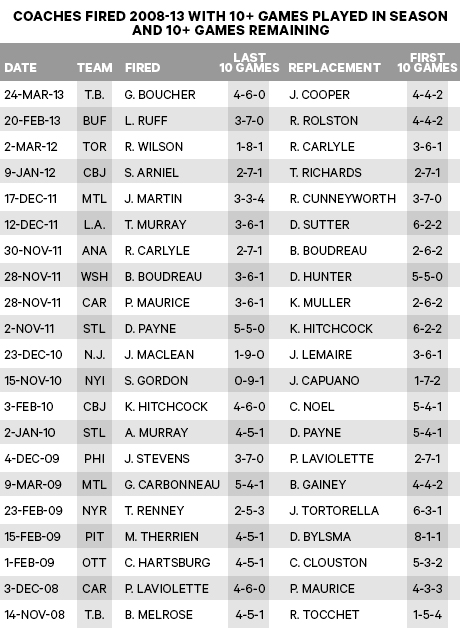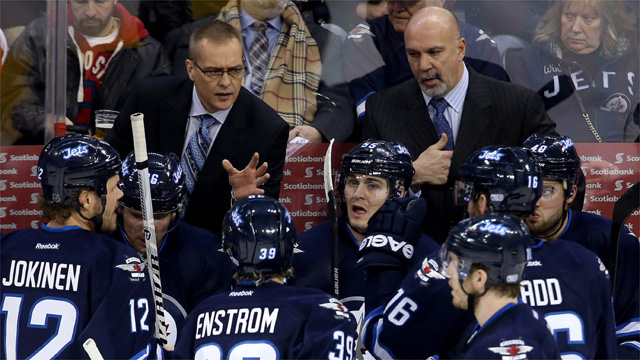The Winnipeg Jets struggled in their ten games leading up to January 12, posting a 3-7-0 record. In circumstances like that, it’s easier to fire a coach than it is to fire a goalie with an .898 save percentage and three years remaining on his deal. If you’re a general manager, it’s probably preferable to fire a coach than to have an internal discussion about the goalie who almost stops nine shots out of ten and whether his presence on the team—which was your decision—is the real problem.
So in keeping with NHL tradition, Claude Noel paid the price for the Jets’ struggles. Paul Maurice has come into Winnipeg and seemingly turned the Jets around. They’ve won his first four games and have crawled into a tie for eleventh in the conference, eight points out of a playoff spot with a game in hand on Minnesota. Realistically, the Jets are still finished—but at least they’ve given the locals something to cheer about.
Paul Maurice’s hot start does not vindicate Winnipeg’s decision to fire Claude Noel. The table below has a list of firings that took place at least 10 games into a season and with at least 10 games remaining in the 2008-13 seasons along with the record of the exiting coach in his final 10 games and the record of the new fellow (this includes any games coached by an interim coach) in his first 10 games. As you can see, most teams post a better record in their first 10 games after a coaching change than they did in the 10 games leading up to it.

The 21 fired coaches posted a collective record of 64-127-19 in the final 10 games before their dismissal. In the first 10 games after their dismissal, their replacements posted a collective record of 81-96-33. That’s an improvement from a 57-point pace to a 75-point pace.
That looks like support for an argument that firing the coach made the team better, vindicating the finely honed senses of general managers as to when a coach has lost the dressing room. It’s not a safe conclusion to draw. In order to get to the point that we can say that with certainty, we need to know a little bit about how those teams improved in the 10 games following the firing.
In the 10 games leading up the coach being fired, the 21 teams in our sample were outscored 672-482. Put another way, they scored 41.8 percent of the goals. This is very bad. They weren’t outshot nearly as badly—they lost on the shot clock by a total of 6391-6048, which works out to 48.6 percent of the shots.
In the 10 games immediately following the firing of the coach, the teams that fired the coach were still outscored, but only by 601-530, which works out to the new coach seeing his team score 46.9 percent of the goals. They also improved on the shot clock, but not by nearly as much. They took 49.2 percent of the shots in the first 10 games post firing. That’s half a percentage point of change in their share of the shots but 5.1 percentage points of positive change in their share of the goals.
How does this happen? As you might have guessed, the answer lies in the shooting and save percentages. During these five years in the NHL, the average team shot 9.1 percent and had a .909 save percentage. For the teams that were about to fire a coach, they shot an abysmal 8 percent and posted an equally horrific .895 save percentage. Once the new coach was behind the bench, the shooting percentage rose to 8.7 percent and the save percentage to .904. It’s still not good, but it’s a lot closer to the league norms.
“Fine,” you might say, “they hire a new coach and he doesn’t make a big difference in the shot share but he obviously says something like ‘You, Pavelec, stop some pucks’ or ‘You, Wheeler, score some goals’ and it works. The team gets better.” It’s possible, but to really be sure of this, we’d have to compare the results achieved by the new coach to the results of teams that go through similar stretches.
If the new coach is really making changes that result in more goals for and fewer goals against as opposed to an unfortunate time suddenly getting more fortunate, we’d expect that teams that went through similar stretches that did not fire their coach would not see as much improvement in their next ten games following such a stretch. This is pretty easily testable.
I went about it by identifying comparable teams to the teams that fired their coach. Comparable teams were defined as those that had a 10-game stretch in which they were within one percentage point of shot share and half a percentage point of save percentage and shooting percentage of one of the teams that did fire a coach. That generates pools of comparators for every team except the 2010-11 Islanders for the 10 games preceding the firing of Scott Gordon. We’ll drop the Islanders from our analysis, which leaves us with 20 teams.
From there, it’s an easy matter of creating a composite of the teams that are comparable to those that didn’t fire the coach, in order to see whether firing the coach produces better results.

The results are pretty startling: there’s essentially no difference between the teams that went through a stretch that prompted them to fire a coach and the teams that went through very similar stretches but did not fire a coach. Teams that fired a coach got 49.2 percent of the shots over the next 10 games and scored 47.2 percent of the goals. Teams that didn’t fire a coach took 49.1 percent of the shots and scored 47.7 percent of the goals.
As counter-intuitive as this might seem, it shouldn’t be that surprising. Studies in other sports have shown similar results. It does have some pretty critical implications for understanding hockey, though. It might be that people are wrong to think that, when coaches get fired, new coaches generally come in and fix things. Maybe teams tend to fire coaches at a time when things are going unusually bad and improvement is inevitable.
This isn’t to say that there aren’t bad coaches or that a team can’t improve by firing the coach. It’s possible that Claude Noel was holding Winnipeg back from achieving what it could and firing him enabled Paul Maurice to launch them to glory. We can’t know what would have happened in the past four games if Noel had still been the coach.
We can, however, say that improvement over Winnipeg’s most recent form was probably inevitable, regardless of who was coaching the team. Maurice has the same players that Noel had. In time, he’ll probably find that he has the same problems.


